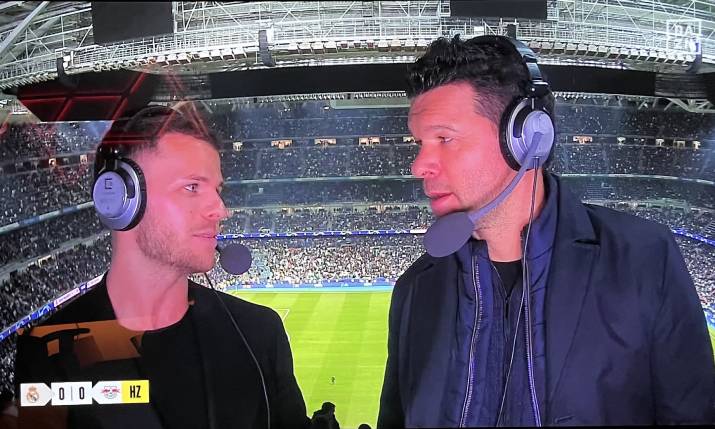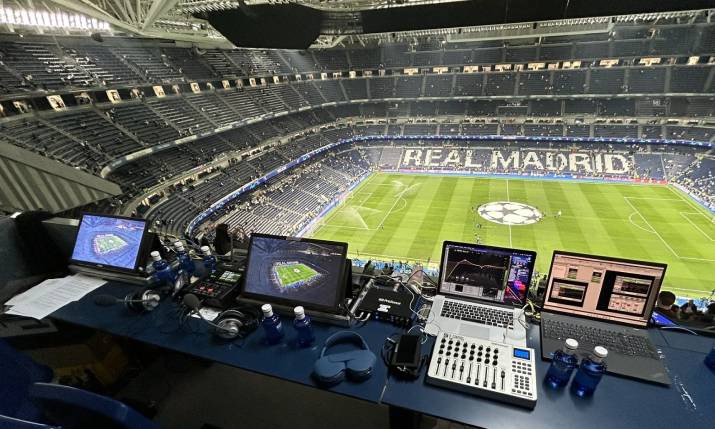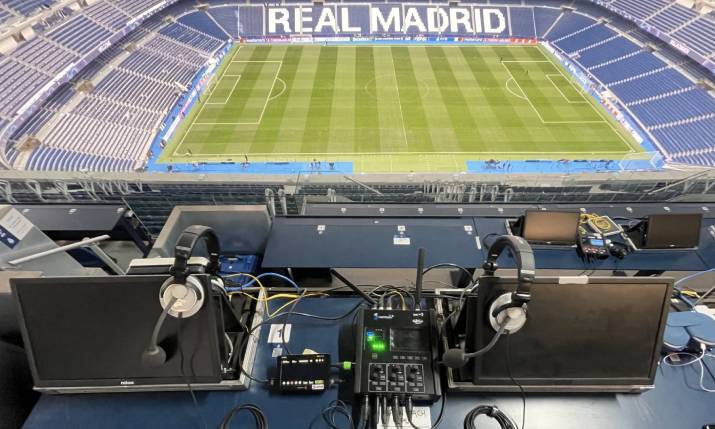Commentary revolution: DAZN’s technical production manager Max Mosgraber talks doing more with less

DAZN commentators Max Siebald [left] and Michael Ballack
Sports commentators don’t just describe what’s happening on the field. The best commentators engage and involve the viewer in the action. They have opinions, they chat, and above all they provide companionship to people listening at home.
Mosgraber already knows all this. With over 10 years of experience in the broadcast industry, he’s worked as a freelance sound engineer and technician for various OB companies in Germany, including TVN, Studio Berlin, NEP, TV Skyline, and HD Broadcast, and has spent time as a media engineer at public broadcaster RBB. So when he saw an opportunity to repurpose existing technologies to improve DAZN’s commentary output he leapt on the opportunity.
Teaming up with select industry partners, he boosted DAZN’s commentary output with additional audio channels, improved quality, added a video feed of the commentary area, and provided a fully redundant mix on an entirely separate backhaul.
He used the same technologies to minimise latency, give audio operators full control over the signal, and provide the commentary team with better information to do their jobs… and he did it with no outside broadcast equipment and no additional transmission lines.
Available resources
Trialling his workflow at the recent UEFA fixture between Real Madrid and RB Leipzig at the Santiago Bernabéu Stadium, he did big remote production on a micro scale. But Mosgraber’s description of what he did is way better: “We condensed the OB van into hand luggage.
“When we attend games in foreign countries we have three commentary options,” says Mosgraber. “At the biggest events like the Bundesliga and UEFA Champions League matches in Germany, we will always send an OB van. For foreign Champions League matches, as a main visiting broadcaster, we may come equipped with our own OB, or more likely we book a full or partially equipped space in the commentary area.”
Like many broadcasters, DAZN adds live commentary from its onsite team to the world feed of the game, supplied on this occasion by Spanish UEFA rights holder Telefonica. In Madrid, Mosgraber secured a partially equipped commentary booth, which as usual included a fibre connection to a 100MBps internet line and two monitors which showed the live match feed to help keep the commentators across the action. Mosgraber felt that even with this limited connectivity, he could do better.

DAZN’s commentary booth at the recent UEFA fixture between Real Madrid and RB Leipzig at the Santiago Bernabéu Stadium
Doing more with less
Pairing a Prodys Quantum² W commentary unit at the stadium with a Quantum AV at DAZN’s production control room (PCR) in Munich, he was not only able to introduce a second commentator track, but a live PTZ camera feed of the commentary area. Providing up to three mic/line inputs, the Quantum² W can embed up to four audio tracks onto a camera feed. Mosgraber only needed two, and he used it to embed isolated commentator audio channels on the camera video output down the Movistar ethernet link to the DAZN PCR in Germany where it was de-embedded via a Quantum² AV unit. Embedding the audio kept everything in sync, and both channels were able to be routed directly into DAZN’s Stagetec mixer for monitoring and mixing into the world feed presentation.
“The biggest benefit for us is being able to deliver a better mix to the gallery, and all without an SNG, OB van or additional dedicated fibre/satellite transmission lines. I think I am the only person in the world working like this, but this workflow was enabled by its simplicity”
To use as much of the available bandwidth as possible, Mosgraber used the BitRate Adaptive Video Encoding (Brave) protocol, which provides network analysis for things like packet loss, packet latency and average bandwidth, and makes bitrate adjustments in real time. Crucially, Brave also gives priority to audio information over video.
“The system effectively creates a small television studio that fits into my travel bag,” says Mosgraber. “We are the first company at the Champions League in Europe – or maybe in the world – that is using a commentary camera at these big football games without needing an OB van on site. It allows us to integrate the commentaries on a transmission line via the internet and because the commentaries are embedded onto the commentary camera it means the camera is an integrated part of the setup.
“On a normal partially equipped remote production the commentary area isn’t able to send or receive vision tracks to or from the PCR, but this workflow means that as well as sending the commentaries and commentator camera feed, we can also get the program feed from the gallery via RX.
“It means the commentators can see all the inserts and graphics, the commercials, the EVS highlight tracks; they can see everything as opposed to just the match feed. It’s a huge benefit to the commentary team because they feel more connected to the production and from a teamwork perspective it’s a much more joined up approach.”
Full redundancy
As a as a main visiting broadcaster, the European Broadcasting Union (EBU) requires DAZN to produce a clean commentary track on audio track four of its transmission line, and Mosgraber took the opportunity to implement a secondary system to ensure that it not only sounds better than before, but provides a solid redundant backup should the internet fibre connectivity encounter any problems.
“The host OB van always retrieves the commentary from the main visiting broadcaster,” he says. “Before we implemented this new system, this audio track was provided from a single XLR output on the Quantum, which wasn’t ideal as both commentators were present and I could only mix via Gain. I felt we could improve the audio quality on that channel too, and we did this using Ableton to mix the commentators at the venue. The Quantum has an audio interface function recognised by my PC which I use to mix both channels. The output feeds a PreSonus audio interface where the host OB can plug an XLR for a mix of both commentators.
“Before Quantum AV, MPEG-L2 was the most common way to send commentator audio over the internet, but now we’ve been using AAC-LD or OPUS, which offers better audio quality, lower latency, and a more stable connection.”
Mosgraber actually used one of his personal MIDI controllers from his home – an old Evolution UC33 – to manage the feeds: “Having access to physical faders and audio processing features like compression gave me much more control over the mix, and the Ableton feed delivers a robust backup to the main broadcast feed from the embedded Prodys line. Meanwhile, the talent has no issues with latency for in-ear monitoring because they are hearing their own mix from the local device.”

The Prodys2W commentary unit set up for DAZN
More, more, more
With the embedded audio feeds in the Prodys environment providing an entirely separate backhaul network to the EBU transmission feed, the risk to the broadcaster is massively reduced. But while it is ultra reliable, Mosgraber says it is more about the quality.
“The biggest benefit for us is being able to deliver a better mix to the gallery, and all without an SNG, OB van or additional dedicated fibre/satellite transmission lines,” he says. “I think I am the only person in the world working like this, but this workflow was enabled by its simplicity. It can be remotely monitored and controlled, requiring only an internet connection.”
Mosgraber plans to use the same system for the UEFA Champions League semi-finals on 30 April and 7 May, and again for the final on 1 June, and like the players on the pitch, he says he is grateful to his team for working with him to develop the system.
“Without my colleagues at DAZN Dach who trusted and supported me from the start, especially my colleagues at PCR, this wouldn’t have been possible, and I would also like to say a big thank you to Rafael Pérez López from Prodys who supported me with the project. I believe that the future of broadcasting lies in compact devices operated via the internet.”

